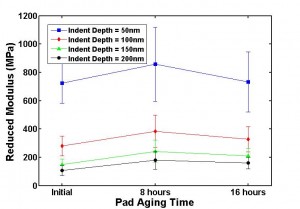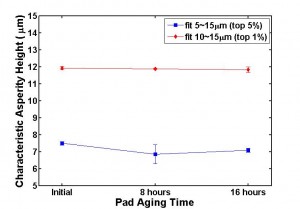Physical Characterization of CMP Pad Properties
- Category: Electronic Devices
- Tags: Duane Boning, Wei Fan
In CMP process, the pad asperity modulus and asperity height are two important properties that affect the planarization results [1] . In this work, physical measurements of pad surface modulus (by nanoindentation) and asperity height (by micro profilometry) are performed on a JSR water soluble particle (WSP) pad [2] . The pad is used to polish 300-mm TEOS wafers with pad conditioning up to 16 hours. Pad aging effects are tested by comparing the measured results from the same location (23 cm from pad center) on the pad after different polishing times (initial, 8 hours, and 16 hours).
The pad asperity modulus is measured using a Hysitron TriboIndenter [3] . Each sample is indented at different depths (50 nm, 100 nm, 150 nm, and 200 nm). Figure 1 shows the measured asperity reduced modulus. There is a strong depth-dependence of the asperity modulus. The asperity modulus decreases when the indent depth increases. However, the asperity modulus is independent of pad aging time. Asperity height distribution of the pad surface is scanned using a Tencor P-10 surface profilometer. Within a scanned region, the exponential distribution [latex]\xi(h)=\frac{1}{\lambda} e ^{-\frac {h}{\lambda}}[/latex] is applied to fit the large asperity heights, where λ is the characteristic asperity height. Figure 2 shows the extracted characteristic asperity height. No time-dependence of asperity height is found. Pad groove depth is considered to be strongly dependent on the polishing/conditioning time. The pad groove depth is measured using the microscope and positioning control system on the Hysitron TriboIndenter. Pad groove depth decreases from 1.05 mm to 0.65 mm along condition time due to pad wear. In summary, pad surface properties (asperity modulus and asperity height) are approximately uniform during the whole polishing/conditioning time. As a result, the conditioning achieves consistent pad surface properties, although pad material is worn in the process.
- Figure 1: Pad asperity modulus. Modulus is measured at four indentation depths for each sample. Error bars indicate one standard deviation based on measurements achieved from a 40 µm × 40 µm testing area.
- Figure 2: Characteristic asperity height. Two 500 µm × 500 µm test regions on each sample are scanned. Error bars indicate one standard deviation based on the characteristic asperity heights extracted from two scanned regions on each sample.
- W. Fan, D. Boning, L. Charns, H. Miyauchi, H. Tano, and S. Tsuji, “Study on Stiffness and Conditioning Effects of CMP Pad Based on Physical Die-Level CMP Model”, J. Electrochem. Soc., vol. 157, no. 5, pp. H526-H533, 2010 [↩]
- “JSR CMP Pad,” http://www.jsr.co.jp/jsr_e/pd/ec/pdf/cmp_p.pdf, last accessed in June 2011 [↩]
- D. S. Boning and W. Fan, “Characterization and Modeling of Pad Asperity Response in CMP”, Mater. Res. Soc. Symp. Proc., vol. 1249, pp.1249-E05-04, 2010 [↩]

